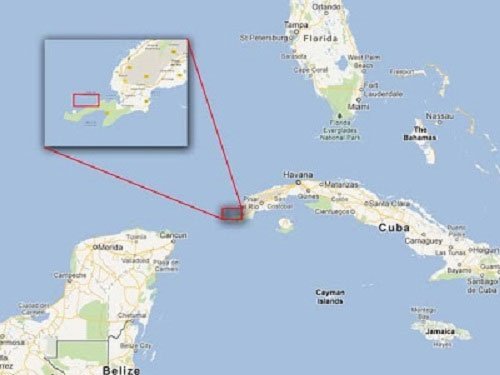A team of explorers were conducting an exploration and survey mission little over ten years ago when their sonar equipment detected an intriguing group of stone constructions 650 meters below the surface. The constructions looked to reveal neatly ordered stones indicative of an urban development and appeared completely similar to the arid "desert" of the ocean below. Soon after, there was a media frenzy, with news websites running titles like "Atlantis Found in Cuba" and "Lost City of the Caribbean Found." The government, national museum, and national geography were all interested in the discovery as well, and they all pledged to look into the unusual sonar images. The tale has since been forgotten, more than ten years later. What ever happened to Cuba's submerged "ruins"? Were they ever thoroughly looked into? And why hasn't the news stopped talking about this peculiar discovery?
The initial discovery was made in 2001 while marine engineer Pauline Zalitzki and her husband Paul Weinzweig, who run the Canadian business Advanced Digital Communications (ADC), were collaborating with the Cuban government on a survey mission off the coast of the Guanahacabibes Peninsula in the Pinar del Ro Province of Cuba. ADC was one of four companies collaborating with the government of President Fidel Castro to explore the Cuban seas, which are thought to be home to thousands of treasure-laden ships from the Spanish colonial era. The crew discovered a collection of symmetrical and geometric stone structures that resembled an urban complex while utilizing cutting-edge sonar technology to investigate a 2-square-kilometer area of the sea floor.
When Zalitzki examined the sonar images, he noticed what seemed to be strange structures of crests, blocks, and geometric forms. Some of the blocks appeared to be constructed in pyramid shapes, while others were round.
In July 2001, they went back to the location with senior researcher and geologist Manuel Iturralde of the Natural History Museum of Cuba. This time, they used a remotely operated vehicle to look at and record the structures. Large, roughly 8-by-10-foot chunks of stone that resembled hewn granite were visible in the photographs. Some of the blocks appeared to be placed on top of one another on purpose, while others appeared to be left alone. Zalitzki stated that although it appeared that the photographs depicted the ruins of a sunken metropolis, he was hesitant to make any judgments in the absence of more information.
Iturralde, an expert in undersea formations, remarked of these "very unique structures" that they had "caught our imagination." But I would struggle to explain this in terms of geology.
According to an estimate, it would have taken 50,000 years for such structures to submerge to the depth where they were allegedly discovered. Iturralde continued, "With any of the cultures we are aware of 50,000 years ago, there was not the architectural capacity to build elaborate buildings." A Florida State University expert in underwater archaeology commented, "If they were correct, that would be cool, but it would be very advanced compared to what we would have seen in the New World at that time. The buildings are both out of place and out of time."
News outlets quickly drew comparisons between the discovery and the mythical lost city of Atlantis during the media frenzy that followed the announcement of its discovery. Zelitsky and Weinzweig, however, resisted drawing such analogies. Zelitsky claimed that the tale is a myth. What we discovered was most likely originally part of a local culture that existed along a 100-mile "land bridge" that connected Cuba and Mexico's Yucatan Peninsula. Iturralde continued by mentioning local myths about the Maya and indigenous Yucatecos that describe an island home to their ancestors that disappeared beneath the waters. Iturralde does not rule out the possibility that the rock formations could simply be the consequence of Mother Nature's miracles, though. He claimed that nature was capable of producing some truly incredible structures.
Others are less inclined to embrace this viewpoint, despite the fact that hundreds of media outlets have covered submerged ruins, advanced civilizations, the lost city of Atlantis, and sunken cities. The depth of the purported ruins, according to Keith Fitzpatrick-Matthews of the debunking website Bad Archaeology, is the largest issue for advocates of the sunken city theory. Sea levels decreased dramatically during the Pleistocene, which was marked by a series of ice ages with a maximum dip of about 100 meters.
It was never above sea level during the Ice Period unless the area on which they were standing had obviously sunk. Atlantis is said to have been destroyed "by terrible earthquakes and floods," according to Plato's version. It is doubtful that an entire city could have survived dropping more than 600 meters into an abyss, Fitzpatrick-Matthews says, assuming we take Plato at his word, which is what we must do if we think that Atlantis was a real location.
If we assume that he is correct and that these stone structures are simply the result of nature rather than representing an ancient submerged city, geologists and other scientists would undoubtedly be quick to seize upon the discovery and look into what freakish natural event produced such peculiar formations. Curiously, no recorded follow-up inquiries have been made, and media sources have completely stopped reporting on the situation. What happened to all the assurances that the government, National Geographic, the National Museum, and other scientists would conduct additional surveys?
Some have questioned whether there has been a concealment of information surrounding the results as a result of the fast dismissal of the story. Fitzpatrick-Matthews asserts that in the end, experts were not persuaded that Zelitsky had actually uncovered a buried metropolis and that the tale just went dead.









